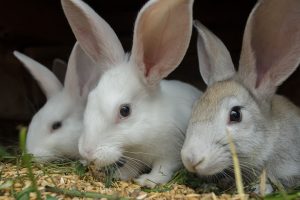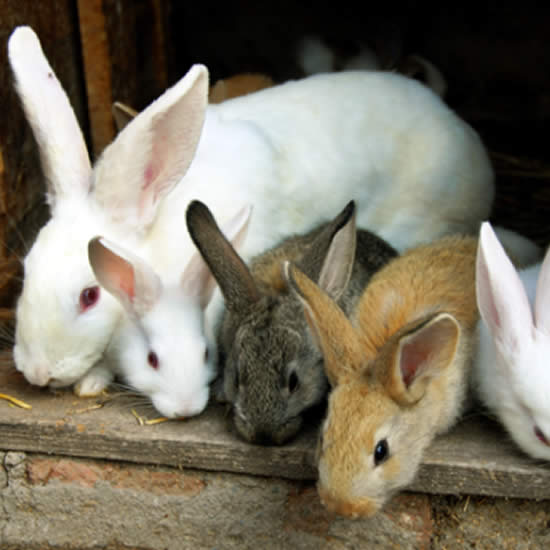
Check out key Rabbits diseases and treatment with standard health plan
Diseases and Treatments
Rabbits are subject to a wide variety of diseases that cause death or decrease the quality of life for survivors. Most diseases can be avoided through good breeding and management practices. A healthy animal is alert and active and has a good, smooth coat. Its droppings are round and firm. Daily observation of the animals will allow you to note the first signs of disease. Remove and isolate the sick animals from the rest of your rabbits. The following is a brief list of common rabbit disease or conditions and treatments:
Abscesses
 Learn More
Learn MoreThese are swelling under the skin caused by bacteria. Drain, clean and apply an antiseptic.
Coccidiosis
Eimeria, an internal parasite, causes a range of problems including diarrhea, dehydration and listlessness. It frequently results in death. Sulfaquinoxaline in drinking water is a common treatment.
Ear Canker or Ear Mange
A mite chews the skin on the side of the ear, causing irritation, redness and soreness. A whitish to tan crusty material develops in the ear. Treatment consists of swabbing the ears (inside and out) as well as the head and neck area with mineral oil or ear mite medication.
Enterotoxemia
Severe diarrhea, dehydration, reduced appetite and rough fur are symptoms of this condition. Usually seen in 4 to 8 weeks of age. Cause is unknown. Antibiotics in the water, higher fiber diets, reducing stress in the rabbitry and strict sanitation reduce the likelihood of an outbreak.
READ ALSO: Fish farming business 101
Mastitis
This illness may develop in nursing does that are heavy milk producers. Mammary glands become swollen, red and hot. Does refuse to nurse the young, go off feed, develop a fever and become depressed. Early antibiotic treatment may save the doe and the litter.
Mucoid Enteritis
A disease common in young fryer rabbits, described as bloat, scours or diarrhea. Symptoms are intense thirst, lack of appetite, rough fur coat, bloated abdomen and either jelly like droppings or constipation. Animals often grind their teeth. Antibiotics are commonly used as treatment. The use of probiotics in feed such as Primalac in Southern States Premium and Southern States Traditions Rabbit Feeds has been helpful in reducing enteritis and improving feed conversion.
Pasteurellosis
Nearly all rabbitiries are infected with the bacteria Pasteurella multocida which causes a variety of infections (snuffles, pneumonia, abscesses, weepy eyes, uterine infections, genital infection and wry neck). First signs of infection are sneezing and a discharge from the nose and eyes. If sneezing persists and if fur begins to mat on front feet (from rabbit wiping its nose with its front paws) one can be reasonably sure of snuffles. Snuffles is very contagious. Infected rabbits go off feed, lose weight and become listless. Rabbits with snuffles should be culled. The best prevention for snuffles is excellent ventilation, good nutrition, minimum stress, proper sanitation and strict culling. High ammonia levels in the air can lead to increased incidence of snuffles but can occur from exposure to drafts, sudden temperature changes or dampness.
Sore Hocks
A common condition in medium-sized and large breeds. Round sores are discovered by hard scabs on rear and sometimes front feet. Rabbits should be removed from wire cage and put on solid floor with dry bedding. Clip hair around sore, wash, and apply iodine.
Tyzzer’s Disease
Severe diarrhea, animals off feed, dehydration and rapid death are symptoms seen in fryer rabbits. No effective treatment exists.
Vent Disease (Rabbit Syphilis)
Small reddish sore or blisters develop around the genital area. These progress to crusty scabs, which may spread to face and feet. Animals should be isolated, and a veterinarian contacted for proper diagnosis and treatment.
Health Program
The most important factors for maintaining a healthy rabbit herd are cleanliness, good ventilation, close observation, and protection from sun and rain. Rabbits are susceptible to several diseases that can reduce production to unprofitable levels.
The respiratory disease caused by Pasturella multocidais responsible for decreased productivity and a high mortality rate in does. Pasturella-free animals can be purchased and may be a good investment.
To help prevent disease problems, do not permit casual visitors inside the rabbitry. They may introduce disease and cause additional stress to the animals. Isolate any sick or injured rabbits immediately. Disinfect the isolation cage and the rabbit’s regular cage to avoid spreading diseases.
For a good health program, you should keep accurate records on each animal. Provide each rabbit with a tattoo identification number or ear tag and attach an identification card with health and breeding information to its hutch.
Please note














